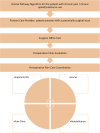Consensus Statement for Clinical Pathway Development for Perioperative Pain Management and Care Transitions
- PMID: 28853044
- PMCID: PMC5693810
- DOI: 10.1007/s40122-017-0079-0
Consensus Statement for Clinical Pathway Development for Perioperative Pain Management and Care Transitions
Abstract
The perioperative surgical home (PSH) model has been created with the intention to reduce costs and to improve efficiency of care and patient experience in the perioperative period. The PSH is a comprehensive model of care that is team-based and patient-centric. The team in each facility should be multidisciplinary and include the input of perioperative services leadership, surgical services, and support personnel in order to provide seamless care for the patient from the preoperative period when decision to undergo surgery is initially made to discharge and, if needed after discharge from the hospital, until full recovery is achieved. PSH is discussed in this consensus article with the emphasis on perioperative care coordination of patients with chronic pain conditions. Preoperative optimization can be successfully undertaken through patient evaluation, screening, and education. Many important positive implications in the PSH model, in particular for those patients with increased potential morbidity, mortality, and high-risk populations, including those with a history of substance abuse or anxiety, reflect a more modern approach to health care. Newer strategies, such as preemptive and multimodal analgesic techniques, have been demonstrated to reduce opioid consumption and to improve pain relief. Continuous catheters, ketamine, methadone, buprenorphine, and other modalities can be best delivered with the expertise of an anesthesiologist and a support team, such as an acute pain care coordinator. A physician-led PSH is a model of care that is patient-centered with the integration of care from multiple disciplines and is ideally suited for leadership from the anesthesia team. Optimum pain control will have a significant positive impact on the measures of the PSH, including lowering of complication rates, lowering of readmissions, improved patient satisfaction, reduced morbidity and mortality, and shortening of hospital stays. All stakeholders should work together and consider the PSH model to ensure the best quality of health care for patients undergoing surgery in the future. The pain management physician's role in the postoperative period should be focused on providing optimal analgesia associated with improved patient satisfaction and outcomes that result in reduced health care costs.
Keywords: Anesthesiologist; Care transition; Multimodal analgesia; Opioid; Pain management; Pathways; Perioperative surgical home.
Figures
References
-
- Clough JD, McClellan M. Implementing MACRA: implications for physicians and for physician leadership. JAMA. 2016;315(22):2397–8. - PubMed
Publication types
Grants and funding
LinkOut - more resources
Full Text Sources
Other Literature Sources


